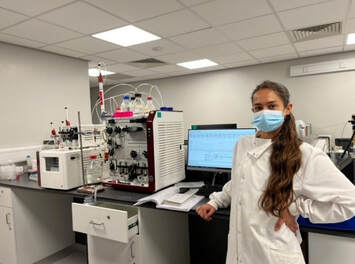
Background
With a broad understanding gained in my Biochemistry and Microbiology Undergraduate degree at Sheffield University, I decided to continue onto a master’s and specialise in a relevant topic of increasing global threat – Antimicrobial Resistance. My 3rd research project was conducted by Dr Mesnage and investigated Clostridium difficile peptidoglycan structure and composition. As a dry lab, we used Microsoft excel and the novel software ‘PGfinder’, along with m/z data from Xcalibur to identify proportions of peptide stem composition found in 2 different strains. The project presented how strains with acquired additional genes can enable alternative crosslinking of peptidoglycan and confer resistance to beta-lactam antibiotics. My interest in AMR was strengthened through this work and directed me to my current program. My 3rd year Literature Review was conducted by Dr Corrigan and examined chemical signaling processes in both Gram-positive and Gram-negative bacteria in response to cellular stresses. I addressed the SOS, Stringent, and Heat-shock response in Escherichia coli and Bacillus subtilis. This research increased my understanding with bacterial communication both intra- and inter-species. I have a keen interest in developing novel therapies for targeting infectious disease. I hope the Research Project will advance my knowledge in bacterial infection dynamics and designed treatments. Florey MSc Research Project Understanding how novel nuclease inhibitors kill bacteria My project focused on identifying novel inhibitors of the flap endonuclease (FEN) enzyme domain of Streptococcus pneumoniae DNA polymerase 1 (SpPol), causing bacterial cell death. SpPol, consisting of polymerase and FEN domains, is involved in bacterial DNA replication and repair. Inhibiting enzyme function via the FEN domain would result in bacterial inhibition via a previously unexplored target. This research works towards reducing antimicrobial resistance and allowing continued use of current treatments, ultimately reducing deaths worldwide. Working in Professor John Sayers’ lab (https://sites.google.com/sheffield.ac.uk/fen/sayers-laboratory) alongside Sarbendra Pradhananga, I carried out a number of techniques. The main processes involved protein purification via AKTA using affinity and ion-exchange chromatography, and assaying potential inhibitors using a FRET based assay, the Maybridge Ro3 and in-house small molecule libraries. The purified SpPol also underwent crystallization trials to produce crystals for X-ray structure determination. Compounds identified from these assays were visualized using Data Warrior and PyMol and docked on PyRx, identifying prime binding sites, affinities, and orientations. IC50 values were deduced from the top hits of over 75% inhibition to further progress development of novel antibiotics for S. pneumoniae. |
The Team
|
